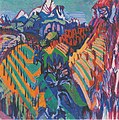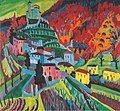Red-blue group
Red-Blue or the Red-Blue group was the name of a Basel artists' association from the 1920s that was close to Expressionism . The two phases of its existence are called “Red-Blue I” and “Red-Blue II”.
The group "Rot-Blau" was founded on New Year's Eve 1924/1925 by Albert Müller , Paul Camenisch and Hermann Scherer . A short time later Werner Neuhaus became the fourth member. The association was founded on the one hand in response to difficult working conditions for young painters and sculptors in Basel. An older generation ( Paul Basilius Barth , Jean Jacques Lüscher , Numa Donzé and Karl Dick ) had established themselves there, taking on the exhibitions in the Kunsthalle Basel and commissions from the state art credit Basel-Stadt . The “Red-Blue” joint venture wanted to break into this monopoly and obtain exhibitions, sales and public procurement for itself. On the other hand, a socially critical approach and a new stylistic orientation against the prevailing dark-tone valued painting also made themselves felt in “Rot-Blau” . " Die Brücke " and Ernst Ludwig Kirchner , whose work was exhibited in Zurich in 1923 and with whom the painters were in personal contact, had a decisive influence on this . The connections to Kirchner are particularly evident in landscapes, in groups of figures and in a high-contrast color palette. The self-designation after the colors red and blue , even if their origin has not been clearly clarified, indicates the importance of these two primary colors in the works of the artist group. Camenisch was later one of the co-founders of Gruppe 33 in Basel.
The group had three exhibitions, but disbanded in 1926 after Müller and Scherer died. A new establishment («Rot-Blau II») lasted 1928–1930. Other members besides the first four were Samuel Wülser , Hans Schmidt, Otto Staiger , Hans Stocker , Fritz Sulzbachner and Charles F. Vaucher. Despite the stylistic similarities, «Red-Blue» did not design a joint or even mandatory artistic program , and its members later each went their own way. The “Red-Blue” group had a decisive influence on painting in Switzerland and helped establish expressionism and artistic modernism .
Hans Stocker: Stained glass in the Antoniuskirche in Basel
literature
- Georg Schmidt : "Rot-Blau" A chapter of Basler Kunst In: Architektur und Kunst , Vol. 14, 1927, pp. 38–56
- Konrad Bitterli: Stations of the artists' association Rot-Blau , Schweizer Kunst, 1999, pp. 64–78
- Beat Stutzer: Albert Müller (1897–1926) and the Basel artist group Rot-Blau. With a critical catalog of the paintings, panes of glass and sculptures. Friedrich Reinhardt, Basel / Prestel, Munich 1981 (Swiss Institute for Art Research. Catalog of works by Swiss artists, 9th)
Web links
- Ketter Kunst: Group "Red-Blue"
- "Expressionism from the Mountains" Kirchner, Bauknecht, Wiegers and the group Rot-Blau. Website for the 2007 exhibition at the Kunstmuseum Bern



